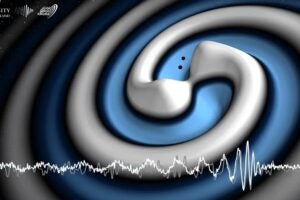AUSTIN, Texas—A new teaching tool providing a three-dimensional view of the human skeleton is available to students and the public at a Website titled www.eSkeletons.org, according to Dr. John Kappelman, a University of Texas at Austin anthropology professor. Kappelman said the site is a project supported by the National Science Foundation’s Digital Library Initiative and Division of Undergraduate Education, as well as the College of Liberal Arts at UT Austin.
“Not long ago it was necessary to have hands-on access to an actual human skeleton if one really wanted to learn the basics of human anatomy. Now, instead of being restricted to the traditional classroom, a student can log on to a Website and have instant access to images and animations of the complete human skeleton,” Kappelman said.
“The point of this project is to use the benefits of universal web access to make the materials needed to teach anatomy available to students and instructors at all educational levels,” Kappelman said. “We have just completed the first high resolution computed tomography (CT) scan of the human skull. This will be of great importance to the student and professional alike.”
Kappelman said future plans for the Website involve adding skeletons of the chimpanzee, gorilla and orangutan, as well as permitting visual comparisons among the same skeletal elements from different species.
“The wild populations of these apes are gravely endangered and it is very difficult for students to study the anatomy of these species,” Kappelman said. “Delivery over the web will permit us to make the material accessible to all students and to raise their awareness of the status of the apes.”
Scanning of the ape skeletons will be carried out in collaboration with the Smithsonian Institute’s National Museum of Natural History in Washington, D.C.
The ability to post the three-dimensional image of a human skeleton on the web has been made possible due to recent advances in computer technology. Kappelman’s lab group at UT Austin used a combination of three-dimensional laser scanners, high resolution X-ray computed tomography (HRXCT) and digital photography to capture information about each skeletal element.
The 3-D laser scanner, built by Digibotics, Inc., of Austin, ran a laser across each bone and precisely recorded its surface coordinates. These coordinates next were rendered as an exact digital replica that can be viewed and manipulated in 3-D on the computer.
“Some of the animations are simple rotations about a fixed axis,” Kappelman explained. “But in the event that the user has a fast computer with sufficient memory, other files offer the user full control over the skeletal object. In either case, the actual bone appears right there on the computer screen.”
The UT CT scanner, built by Bio-Imaging Research, Inc., of Lincolnshire, Ill., operates like the conventional CAT scanner now found in most hospitals but offers much higher resolution and permits mapping of the internal features of the skeleton.
Digital photography was used to capture high-resolution images of the various bones of the skeleton. The Website’s user interface provides buttons that can be used to turn on and off color overlays and labels of each element’s bony landmarks and muscle markings in order to test the student’s anatomical knowledge.
One of the newest technological advances to play a role in the eSkeletons Website is the ability to print out 3-D files of each skeletal element as full-sized or even scaled-down replicas of the original.
The process that binds powder into an exact 3-D replica of an object was invented by Z Corporation of Somerville, Mass. This process is commonly used in prototyping and reverse engineering, but the particular use here represents one of its first anatomical applications as delivered over the web, Kappelman explained.
“The eSkeletons Website provides the user with three-dimensional files of the skeleton that, with access to a 3-D printer, can be used to produce an exact replica,” said Kappelman. “We remain a species trained to use our hands to understand our environment, and the ability to have readily available 3-D replicas will prove to be a real advantage in teaching situations.”
Note to Editors: For more information, contact Dr. John Kappelman of the UT Austin department of anthropology, at (512) 471-0055 or (512) 589-3693, or Charles R. Smith, Bio-Imaging Research Inc., 425 Barclay Blvd.,Lincolnshire, IL 60069. Phone (847)634-6425, www.bio-imaging.com.
Photos are available from Marsha Miller at the Office of Public Affairs at (512) 471-3151 or on the Web at /opa/news/00newsreleases/nr_200004/nr_skeleton2.html Kappelman’s Website is: http://www.dla.utexas.edu/depts/anthro/people/faculty/kappelman/kapp.html. Additional information is available from Jeff Koch of Digibotics, Inc., of Austin at http://www.digibotics.com; Z Corporation of Somerville, Mass. at (617) 628-2781; and from Dr. C. Dianne Martin, computer science program director at the Division of Undergraduate Education, National Science Foundation (703) 306-1665 (ext. 5886) or Dr. Stephen M. Griffin, program director of the Special Projects Digital Libraries Initiative at the National Science Foundation (703) 306-1930.



